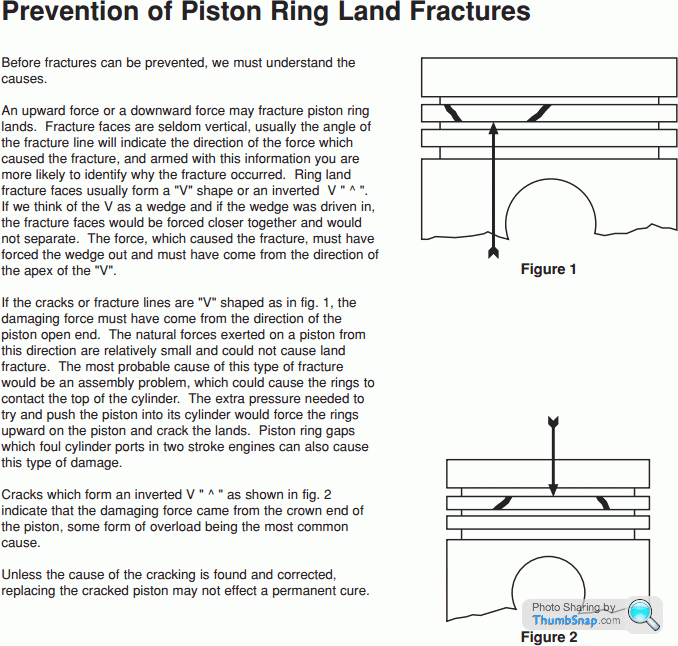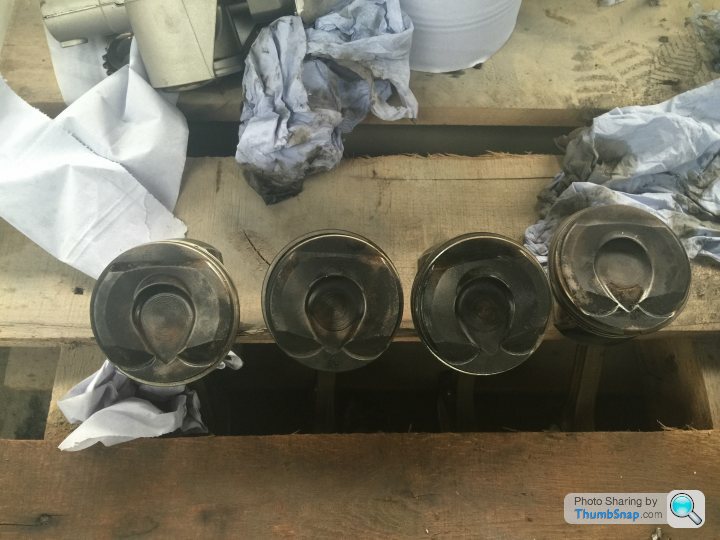replacing only one piston
Discussion
Thinking about the heat gradient, I would expect to see some pretty obvious signs of detonation on the piston crowns, this usually shows up as a clean dull grey area peppered with small inclusions. The fact the top land is intact may suggest that perhaps the piston was damaged by mishandling rather by some problem with the running of the engine. Do you have a close up picture of the crown on the damaged side of the piston?
If you are fitting a new piston then you don't need to do anything to it prior to fitting, just ensure the bore is glaze busted. The thrust faces of the piston appear to be coated with a xylon or similar coating to aid running in so there should be few issues there.
Dave
If you are fitting a new piston then you don't need to do anything to it prior to fitting, just ensure the bore is glaze busted. The thrust faces of the piston appear to be coated with a xylon or similar coating to aid running in so there should be few issues there.
Dave
Dave, That inverted V is the giveaway. If the piston was damaged severely on fitment it would have had a V pattern angle fracture and it hasn't it shows an inverted V so the damage must have occurred from above the piston. ie too much pressure. It doesn't need to show prolonged nibbling above the top ring or on the crown to have failed from detonation. This sort of failure is very common on turbo engines. We have also seen it on 13:1 CR race engines when too much advance causes the same problem. The problem is so severe the ringland cracks, traps the rings then the rest is history, all before the characteristic det pattern nibbling shows up on the crown or side of piston above top ring. The second pic shows the inverted V even better than the first.
Peter
Peter
PeterBurgess said:
Dave, That inverted V is the giveaway. If the piston was damaged severely on fitment it would have had a V pattern angle fracture and it hasn't it shows an inverted V so the damage must have occurred from above the piston. ie too much pressure. It doesn't need to show prolonged nibbling above the top ring or on the crown to have failed from detonation. This sort of failure is very common on turbo engines. We have also seen it on 13:1 CR race engines when too much advance causes the same problem. The problem is so severe the ringland cracks, traps the rings then the rest is history, all before the characteristic det pattern nibbling shows up on the crown or side of piston above top ring. The second pic shows the inverted V even better than the first.
Peter
I wouldn't be so sure; det on a modern boosted 4vpc engine generally occurs around the inlet valves. The damage in the above pic is at 90' to that. I've seen ringland breakages different to your inverted V too with det. Peter
We are commenting on the pics shown and they show the inverted V. Other damage can and does occur but in this instance it displays text book too much pressure from above wrecking the ring land and then subsequent overheating/seizing/breakdown of oil film etc etc and the piston (and maybe the bore) has substantial damage. The other pistons may well exhibit the same problem but less advanced, maybe tight or trapped top ring?
Peter
Peter
As stated earlier, det' occurs around the inlet valve part of a piston on a boosted 4vpc engine, the shock waves are transferred down to the ringlands below which break, these are either directly below as you would imagine, or off to one side a bit. This makes sense as the squish pad is the point of maximum pressure.

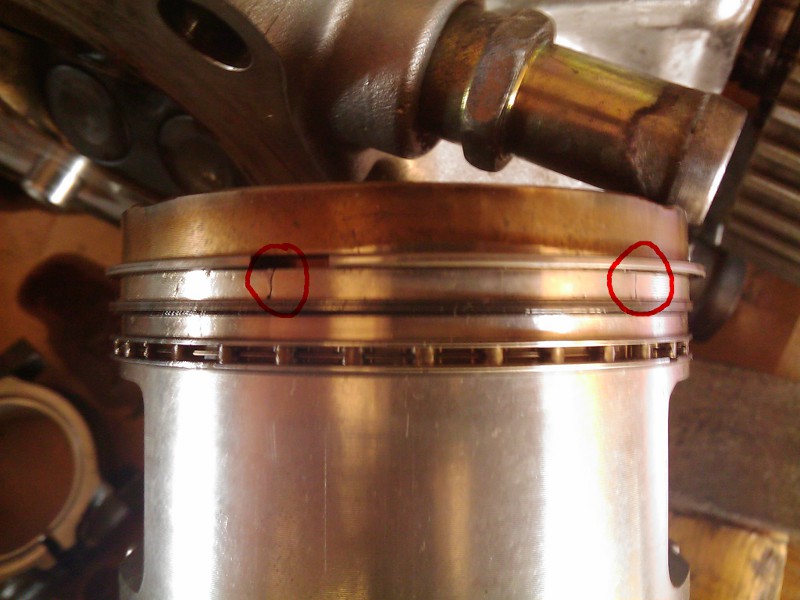



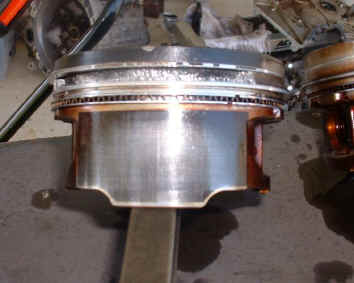
Note position and no inverted Vs. I'm assuming that theory to be based on older 2vpc engines which can have the squish pad nearer to the gudgeon pin area of the piston.
I don't know why we have two offerings of pics of the same engine in this thread, is this the same person or two people?
Why was the cylinder head repaired? More to this story than initially meets the eye I think.
Note the cracks around the gudgeon pin:
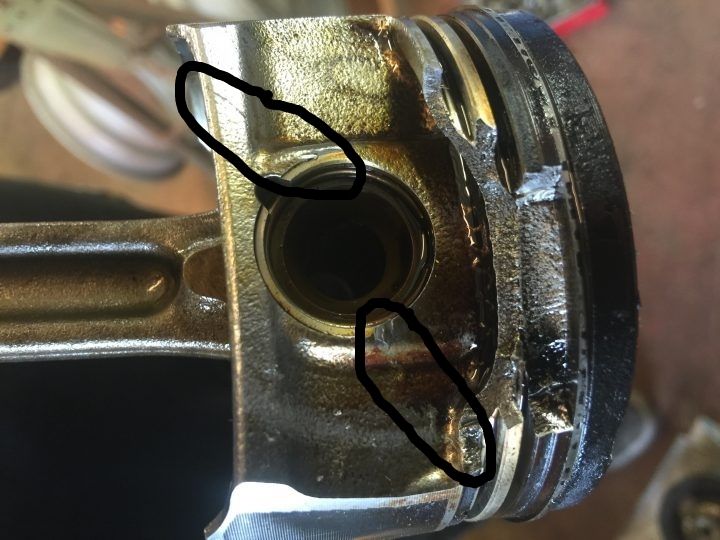
Caused by det? Why the damaged head? Over rev?
A full set of forged pistons can be had for the Mini engine for £600.
We do seem to have veered away from the original question somewhat though!






Note position and no inverted Vs. I'm assuming that theory to be based on older 2vpc engines which can have the squish pad nearer to the gudgeon pin area of the piston.
I don't know why we have two offerings of pics of the same engine in this thread, is this the same person or two people?
Why was the cylinder head repaired? More to this story than initially meets the eye I think.
Note the cracks around the gudgeon pin:

Caused by det? Why the damaged head? Over rev?
A full set of forged pistons can be had for the Mini engine for £600.
We do seem to have veered away from the original question somewhat though!
Edited by 227bhp on Wednesday 15th July 08:49
I cannot see why over revving would do that to a piston? Overrevving usually seems to show up as shagged ring lands (worn out so too wide) and barrel pattern wear in the bores.
Nice pics of your broken lands, from your pics it still looks like an inverted V as the cracks do not appear 90 degree, but that may be the pic angle?. As I said earlier we were asked about the pics of the Mini piston and it cries out excess pressure from above. If the material is brittle it will fail very easily as shown, including the cracked gudgeon pin boss.
On a few of occasions we have seen wrecked ring lands/nipped rings when a rocker arm has broken on an ex valve and allowed excess pressure in the cylinder. On one occasion the customer had low compression on the cylinder after repairing the rocker assembly. He knew the top ring at least must have nipped, amazingly after 50 miles of use the ring must have made its own clearance again and compression restored...lucky bloke, if it was my engine it would have required a complete rebuild!
Peter
Nice pics of your broken lands, from your pics it still looks like an inverted V as the cracks do not appear 90 degree, but that may be the pic angle?. As I said earlier we were asked about the pics of the Mini piston and it cries out excess pressure from above. If the material is brittle it will fail very easily as shown, including the cracked gudgeon pin boss.
On a few of occasions we have seen wrecked ring lands/nipped rings when a rocker arm has broken on an ex valve and allowed excess pressure in the cylinder. On one occasion the customer had low compression on the cylinder after repairing the rocker assembly. He knew the top ring at least must have nipped, amazingly after 50 miles of use the ring must have made its own clearance again and compression restored...lucky bloke, if it was my engine it would have required a complete rebuild!
Peter
227bhp said:
I don't know why we have two offerings of pics of the same engine in this thread, is this the same person or two people?
Why was the cylinder head repaired? More to this story than initially meets the eye I think.
Let me try and fill in some of the gaps, for the purpose of this thread, consider me as the owner and Paul the engine builder (who has a better camera on his phone than me hence why I don't have any pics).Why was the cylinder head repaired? More to this story than initially meets the eye I think.
Edited by 227bhp on Wednesday 15th July 08:49
Original owner suffers misfire and coasts into a garage and asks them to check it over. The initial diagnosis for the misfire was put down to either a spark plug or valve. The head was removed for the previous owner (before my son). The bores and piston tops were examined and checked and thought to be good. This led to the thought that the head was at fault so the previous owner commissioned the head rebuild thinking the the loss of compression was a valve seat. Valves had new seats cut and lapped, head was rebuilt and tested. Previous owner then loses interest and sells the car to my son.
So we get the car thinking we had a simple job of fitting the head but check the bores with some white spirit and find piston / rings at fault leading to the strip down, subsequent findings and request for advice on here. Alot of the car is unknown and info is coming through third parties but from what has been said on this thread it looks like the boost could have been turned up and engine ragged.
PeterBurgess said:
I cannot see why over revving would do that to a piston? Overrevving usually seems to show up as shagged ring lands (worn out so too wide) and barrel pattern wear in the bores.
Nice pics of your broken lands, from your pics it still looks like an inverted V as the cracks do not appear 90 degree, but that may be the pic angle?. As I said earlier we were asked about the pics of the Mini piston and it cries out excess pressure from above. If the material is brittle it will fail very easily as shown, including the cracked gudgeon pin boss.
On a few of occasions we have seen wrecked ring lands/nipped rings when a rocker arm has broken on an ex valve and allowed excess pressure in the cylinder. On one occasion the customer had low compression on the cylinder after repairing the rocker assembly. He knew the top ring at least must have nipped, amazingly after 50 miles of use the ring must have made its own clearance again and compression restored...lucky bloke, if it was my engine it would have required a complete rebuild!
Peter
If we could only be that lucky. Does this excess pressure from the top suggest boost pressures then? If so then my plan to have it checked on the rolling road seems to be the way forward then after having the other pistons crack detected.Nice pics of your broken lands, from your pics it still looks like an inverted V as the cracks do not appear 90 degree, but that may be the pic angle?. As I said earlier we were asked about the pics of the Mini piston and it cries out excess pressure from above. If the material is brittle it will fail very easily as shown, including the cracked gudgeon pin boss.
On a few of occasions we have seen wrecked ring lands/nipped rings when a rocker arm has broken on an ex valve and allowed excess pressure in the cylinder. On one occasion the customer had low compression on the cylinder after repairing the rocker assembly. He knew the top ring at least must have nipped, amazingly after 50 miles of use the ring must have made its own clearance again and compression restored...lucky bloke, if it was my engine it would have required a complete rebuild!
Peter
It suggests high cylinder pressure, maybe a pressure spike. As suggested by Peter earlier it could be from to much ignition advance, to high a boost setting, pre-ignition etc. What you're after is a nice controlled burn in the cylinder as opposed to an explosion.
If this were my engine I'd settle for a low boost installation and then get it set up safely. Have fun with that for a while and clock up some mileage whilst paying attention to the engine ;-)
If this were my engine I'd settle for a low boost installation and then get it set up safely. Have fun with that for a while and clock up some mileage whilst paying attention to the engine ;-)
Ebo100 said:
227bhp said:
I don't know why we have two offerings of pics of the same engine in this thread, is this the same person or two people?
Why was the cylinder head repaired? More to this story than initially meets the eye I think.
Let me try and fill in some of the gaps, for the purpose of this thread, consider me as the owner and Paul the engine builder (who has a better camera on his phone than me hence why I don't have any pics).Why was the cylinder head repaired? More to this story than initially meets the eye I think.
Edited by 227bhp on Wednesday 15th July 08:49
Original owner suffers misfire and coasts into a garage and asks them to check it over. The initial diagnosis for the misfire was put down to either a spark plug or valve. The head was removed for the previous owner (before my son). The bores and piston tops were examined and checked and thought to be good. This led to the thought that the head was at fault so the previous owner commissioned the head rebuild thinking the the loss of compression was a valve seat. Valves had new seats cut and lapped, head was rebuilt and tested. Previous owner then loses interest and sells the car to my son.
So we get the car thinking we had a simple job of fitting the head but check the bores with some white spirit and find piston / rings at fault leading to the strip down, subsequent findings and request for advice on here. Alot of the car is unknown and info is coming through third parties but from what has been said on this thread it looks like the boost could have been turned up and engine ragged.
Gassing Station | Engines & Drivetrain | Top of Page | What's New | My Stuff



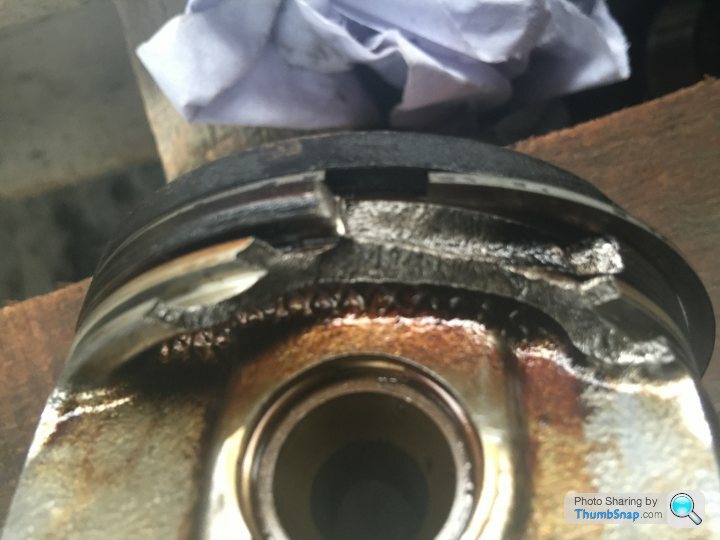
 ked up'.
ked up'. 
